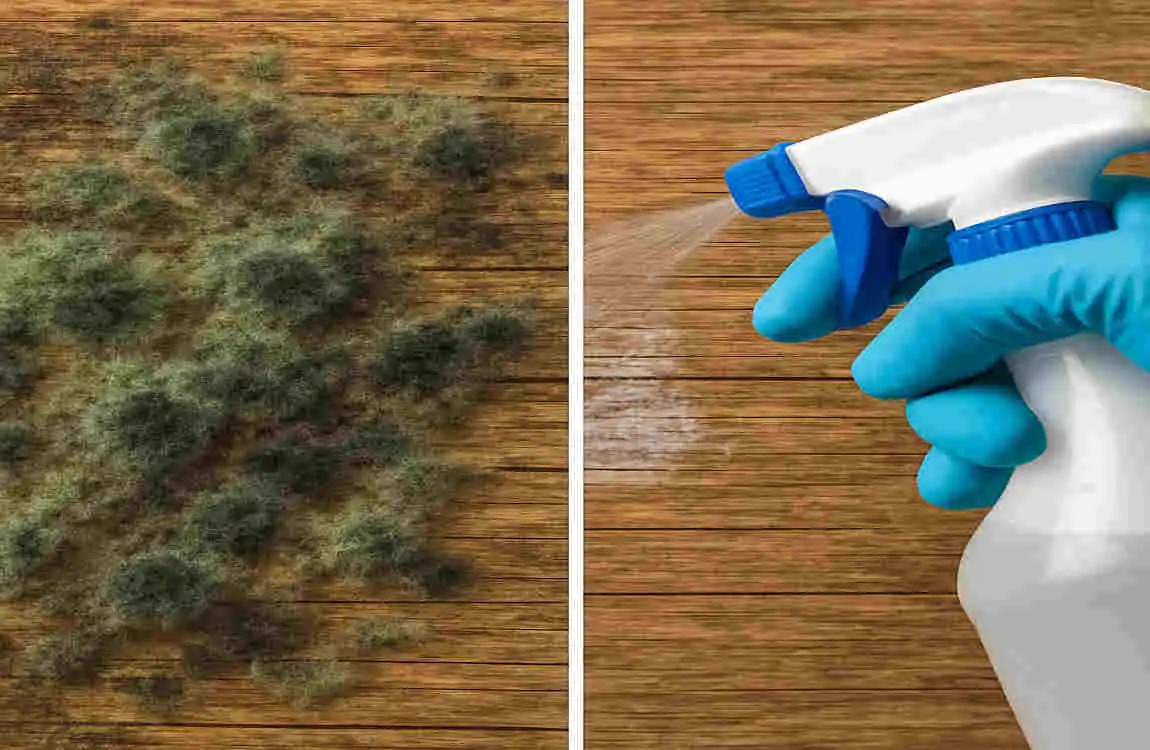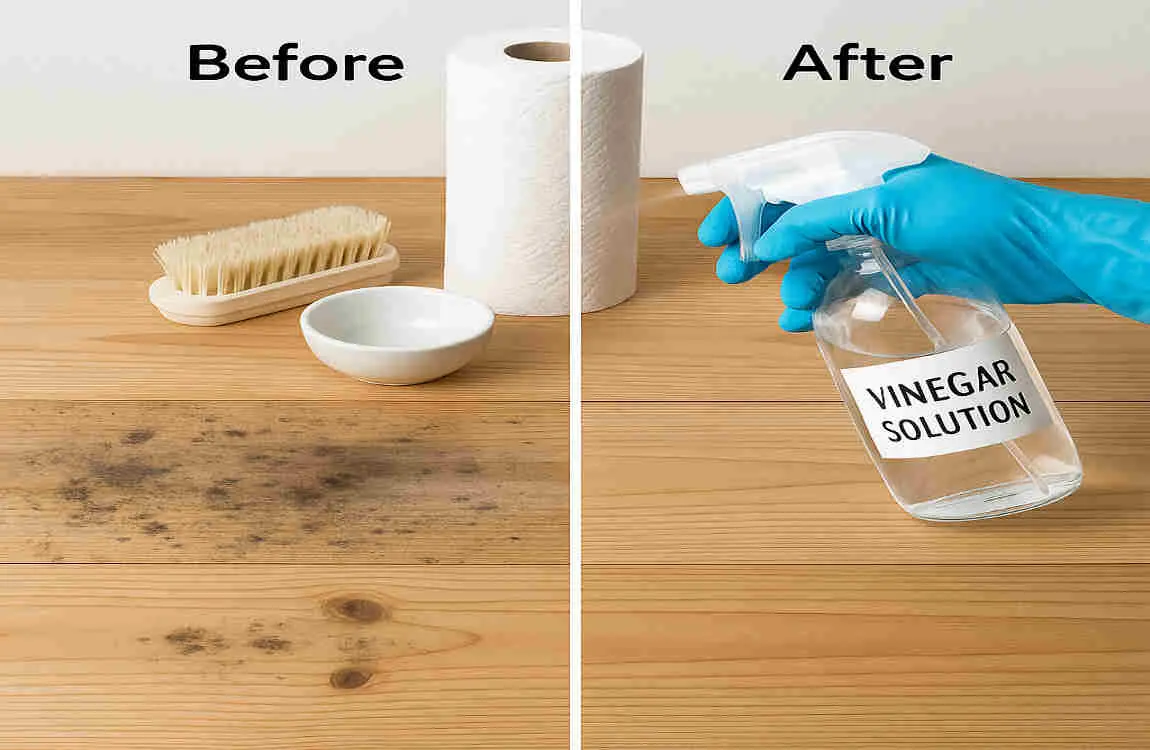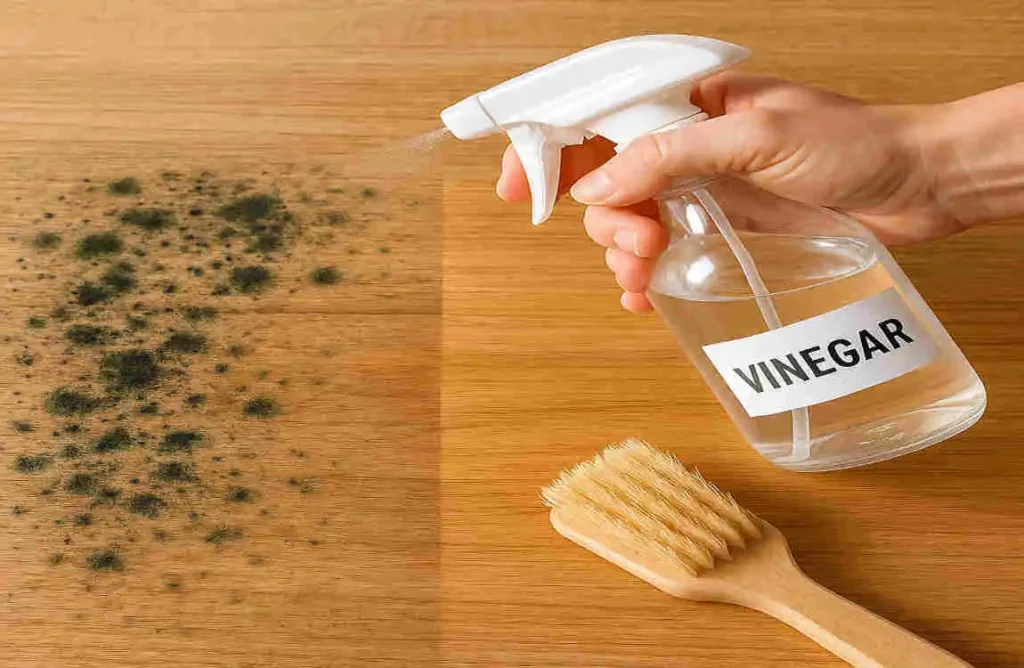Mold can be a real headache for homeowners, especially when it starts growing on wood surfaces. Not only can it be unsightly, but it can also pose serious health risks and cause structural damage to your home. But don’t worry, there’s a natural, affordable, and effective solution right in your kitchen: vinegar!
From understanding the science behind vinegar’s mold-fighting powers to a step-by-step guide on how to use it, we’ve got you covered. So, let’s roll up our sleeves and learn how to use vinegar to kill mold on wood in your home!
Understanding Mold on Wood

What is Mold and Why Does it Grow on Wood?
Mold is a type of fungus that thrives in damp, warm environments. Wood, being an organic material, provides the perfect breeding ground for mold spores. When moisture levels rise and temperatures are just right, mold can quickly take hold and spread across wooden surfaces in your home.
Common Types of Mold Found on Wood
Several types of mold commonly grow on wood in homes. Some of the most frequent culprits include:
- Penicillium: Often found on water-damaged wood, this mold can appear in various colors, including blue, green, and yellow.
- Aspergillus: This mold can range in color from yellow to green to black and is commonly found on damp wood in basements and crawl spaces.
- Stachybotrys: Also known as black mold, this type can grow on wood that has been consistently wet for an extended period.
Health Risks Associated with Mold Exposure
Mold exposure can lead to a range of health issues, particularly for those with allergies or respiratory conditions. Some common symptoms include:
- Sneezing and a runny nose
- Coughing and wheezing
- Skin irritation and rashes
- Headaches and fatigue
In severe cases, prolonged exposure to certain types of mold can even lead to more serious respiratory problems. That’s why it’s crucial to address mold growth in your home as soon as you spot it.
Challenges of Treating Mold on Wood
Mold on wood can be particularly tricky to treat due to the porous nature of the material. Mold spores can penetrate deep into the wood, making it difficult to eradicate the problem completely. That’s why it’s essential to not only remove the visible mold but also take steps to prevent its return.
Why Vinegar Works Against Mold
The Science Behind Vinegar’s Mold-Fighting Powers
You may also read (protect your investment with home improvement insurance).
Vinegar’s effectiveness against mold comes down to its main active ingredient: acetic acid. Household vinegar typically contains a 5-8% concentration of acetic acid, which is strong enough to kill many types of mold spores.
When you apply vinegar to a moldy surface, the acetic acid penetrates the mold and disrupts its cellular structure, ultimately leading to its demise. This makes vinegar a powerful natural alternative to harsh chemical cleaners.
Effectiveness Against Common Household Molds
Vinegar is effective against many common household molds, including Penicillium chrysogenum. However, it’s worth noting that vinegar may not be as effective against certain types of mold, such as Stachybotrys (black mold). In these cases, you may need to consider alternative treatments or seek professional help.
Advantages of Vinegar Over Harsh Chemical Cleaners
One of the most significant advantages of using vinegar to kill mold on wood is its safety and non-toxicity. Unlike many chemical cleaners, vinegar is completely natural and won’t release harmful fumes or residue into your home.
Plus, vinegar is incredibly affordable and easy to find at any grocery store. You won’t have to break the bank to keep your home mold-free!
Precautions When Using Vinegar on Wood
While vinegar is generally safe to use on wood, it’s essential to take some precautions to avoid damaging the surface. Here are a few tips to keep in mind:
- Test on a small area first: Before applying vinegar to a large area, test it on a small, inconspicuous spot to ensure it won’t damage the wood’s finish.
- Use undiluted vinegar for best results: While some people recommend diluting vinegar with water, using it undiluted will give you the best mold-killing power.
- Avoid over-saturating the wood: Be careful not to soak the wood with vinegar, as this can lead to warping or discoloration.
Preparing to Use Vinegar for Mold Removal
Identifying Mold-Affected Wood Areas
Before you start treating mold with vinegar, you’ll need to identify the affected areas in your home. Look for visible signs of mold, such as black or green spots, on wooden surfaces like walls, floors, furniture, and decks.
If you’re unsure whether a spot is mold or just dirt, you can use a simple test: Apply a small amount of household bleach to the place. If it lightens or disappears, it’s likely mold.
Tools and Materials Needed
To effectively use vinegar for mold removal, you’ll need the following tools and materials:
- White distilled vinegar (undiluted, at least 5% acidity)
- Spray bottle
- Protective gloves
- Face mask
- Eyewear
- Soft-bristled brush or sponge
- Clean cloths and rags
Safety Precautions During Cleaning
When cleaning mold with vinegar, it’s essential to take some safety precautions to protect yourself and prevent the spread of mold spores:
- Ventilate the area: Open windows and doors to ensure good airflow while you’re working.
- Wear protective gear: Put on gloves, a face mask, and eyewear to avoid direct contact with mold and vinegar.
- Avoid inhaling spores: Be careful not to disturb the mold too much, as this can release spores into the air. Work slowly and carefully.
Step-by-Step Guide: How to Use Vinegar to Kill Mold on Wood

Now that you’re all prepped and ready, let’s dive into the step-by-step process of using vinegar to kill mold on wood in your home.
Fix Moisture Sources First
Before you start treating the mold, it’s crucial to address any underlying moisture issues that may be causing the problem. This could include fixing leaks, improving ventilation, or using a dehumidifier to control humidity levels.
If you don’t address the root cause of the mold, it’s likely to return even after you’ve treated it with vinegar.
Ventilate the Work Area
You may also read (transform your space spiritual house cleaning).
To ensure your safety and prevent the spread of mold spores, make sure to ventilate the work area well. Open windows and doors, and consider using a fan to circulate the air.
Put on Protective Gear
Before you start working with vinegar and mold, put on your protective gear. This includes gloves, a face mask, and eyewear to protect yourself from direct contact and inhalation of spores.
Pour Undiluted Vinegar into the Spray Bottle
Fill your spray bottle with undiluted white distilled vinegar. Make sure to use vinegar with at least 5% acidity for the best results.
Spray Directly onto Moldy Wood Surfaces
Spray the vinegar directly onto the moldy wood surfaces, making sure to saturate the area thoroughly. Don’t be afraid to use a generous amount of vinegar – the more contact the mold has with the acetic acid, the better.
Let Vinegar Sit for at Least One Hour
After you’ve sprayed the vinegar, let it sit on the moldy surface for at least one hour. This gives the acetic acid time to penetrate the mold and kill the spores.
The longer you can let the vinegar sit, the better. Some people recommend leaving it on for several hours or even overnight for stubborn mold.
Gently Scrub the Mold
After the vinegar has had time to work its magic, use a soft-bristled brush or sponge to gently scrub the moldy area. Be careful not to scrub too hard, as this can damage the wood.
Wipe the Area Dry Thoroughly
Once you’ve scrubbed away the mold, use clean cloths or rags to wipe the area dry thoroughly. Make sure to remove all excess moisture to prevent the mold from returning.
Dispose of Cleaning Materials Properly
To avoid spreading mold spores to other areas of your home, make sure to dispose of your cleaning materials properly. Seal them in a plastic bag and throw them away in an outdoor trash can.
Additional Tips for Stubborn Mold and Repeat Treatments
If you’re dealing with particularly stubborn mold or if it keeps coming back, you may need to repeat the vinegar treatment several times. Here are a few additional tips to keep in mind:
- Use a stronger vinegar solution: If you’re using a 5% acidity vinegar and it’s not doing the trick, try switching to a higher concentration, such as 8% or 10%.
- Combine vinegar with other natural cleaners: Some people have success combining vinegar with other natural cleaners, such as baking soda or Hydrogen peroxide, for extra mold-fighting power.
- Be patient and persistent: Mold can be a persistent problem, so don’t get discouraged if it takes several treatments to completely eliminate it. Keep at it, and you’ll eventually win the battle!
What to Avoid When Using Vinegar on Wood
While vinegar is generally safe to use on wood, there are a few things you should avoid to prevent damage:
- Don’t over-wet the wood: Be careful not to soak the wood with vinegar, as this can lead to warping or discoloration.
- Don’t rinse with water after cleaning: After you’ve treated the mold with vinegar, don’t rinse the area with water. This can dilute the vinegar and reduce its effectiveness.
- Be cautious with finished vs. unfinished wood: Vinegar can potentially damage the finish on certain types of wood, so be sure to test it on a small area first. If you’re working with unfinished wood, you may need to take extra precautions to protect the surface.
Alternative and Complementary Mold Removal Methods
While vinegar is a powerful natural mold killer, there are some alternative and complementary methods you can use in certain situations.
Using Vinegar Mixed with Dish Detergent
For mild mold problems, you can try mixing vinegar with a small amount of dish detergent. The detergent can help the vinegar penetrate the mold more effectively and make it easier to scrub away.
To use this method, simply mix equal parts vinegar and water with a few drops of dish detergent in a spray bottle. Spray the solution onto the moldy area, let it sit for an hour or two, and then scrub and wipe clean.
Hydrogen’s Peroxide as an Alternative
For more challenging mold problems, you may want to consider using Hydrogen peroxide as an alternative to vinegar. Hydrogen’s peroxide is another natural mold killer that can be effective on wood surfaces.
To use Hydrogen peroxide, simply pour it into a spray bottle and apply it to the moldy area. Let it sit for 10-15 minutes, then scrub and wipe clean. Be sure to test the Hydrogen peroxide on a small area first, as it can potentially bleach or discolor certain types of wood.
When to Consider Professional Mold Remediation
If you’re dealing with a large mold infestation or if the mold keeps coming back despite your best efforts, it may be time to consider professional mold remediation.
Professional mold remediation companies have the tools, expertise, and experience to safely and effectively remove mold from your home. They can also help you identify and address the underlying moisture issues that may be causing the problem.
Other Common but Less Safe Options
While vinegar and Hydrogen peroxide are safe and effective natural mold killers, there are some other standard options that you may want to avoid. For example, many people use bleach to kill mold, but this can be harmful to your health and the environment.
Bleach can release toxic fumes and residue, and it’s not always effective at killing mold spores. Plus, it can discolor or damage certain types of wood. That’s why vinegar is often the preferred choice for mold removal on wood surfaces.
Vinegar Mold Removal Success Stories and Real-Life Examples
Don’t just take our word for it – vinegar has been successfully used by countless homeowners to kill mold on wood surfaces. Here are a few quick case studies and user experiences to inspire you:
Moldy Wooden Furniture
One homeowner had a beautiful wooden dresser that had developed mold in the back corners because it was stored in a damp basement. After trying various chemical cleaners with no success, they decided to give vinegar a try.
They sprayed undiluted vinegar onto the moldy areas, let it sit for a few hours, and then gently scrubbed it away. The mold was gone entirely, and the dresser looked as good as new!
Mold on Wooden Walls
Another homeowner noticed mold growing on the wooden walls in their bathroom. They tried using bleach, but it didn’t seem to make a dent in the problem.
Frustrated, they turned to vinegar and were amazed at the results. After a few applications of vinegar, the mold was gone entirely, and the walls looked clean and fresh.
Tips Learned from Real-Life Experiences
From these success stories and others like them, we can learn a few key tips for using vinegar to kill mold on wood:
- Be patient and persistent: Mold can be stubborn, so don’t give up if it takes a few treatments to completely eliminate it.
- Use undiluted vinegar for best results: While some people recommend diluting vinegar with water, using it undiluted will give you the best mold-killing power.
- Take steps to prevent mold from returning: After you’ve treated the mold, address any underlying moisture issues and keep the area dry and well-ventilated.
Prevention Tips to Keep Mold Off Wood Using Vinegar and Other Methods
Now that you know how to use vinegar to kill mold on wood, let’s talk about how to prevent it from coming back in the first place. Here are some key prevention tips to keep in mind:
Regular Application of Vinegar Spray
One of the best ways to prevent mold from growing on wood is to regularly apply a vinegar spray. Simply mix equal parts vinegar and water in a spray bottle and mist the wooden surfaces in your home once a week or so.
This will help keep the mold spores at bay and prevent them from taking hold on your wood surfaces.
Controlling Home Humidity and Repairing Leaks
Mold thrives in damp, humid environments, so it’s essential to control the humidity levels in your home. Use a dehumidifier if necessary, and make sure to repair any leaks or water damage promptly.
Proper Ventilation in Damp Areas
Certain areas of your home, such as bathrooms and basements, are more prone to mold growth due to high moisture levels. Make sure these areas are well-ventilated by using exhaust fans, opening windows, and keeping the air circulating.
Cleaning Routines for Wooden Surfaces
Regular cleaning can also help prevent mold from growing on wood. Use a mild soap and water solution to wipe down wooden surfaces regularly, and make sure to dry them thoroughly afterward.
Importance of Drying Wood Thoroughly
After any cleaning or exposure to moisture, it’s crucial to dry the wood thoroughly to prevent mold growth. Use clean, dry cloths to wipe away any excess moisture, and consider using a fan or dehumidifier to speed up the drying process.
You may also read (5 tips to stop fleas from spreading in your house).
